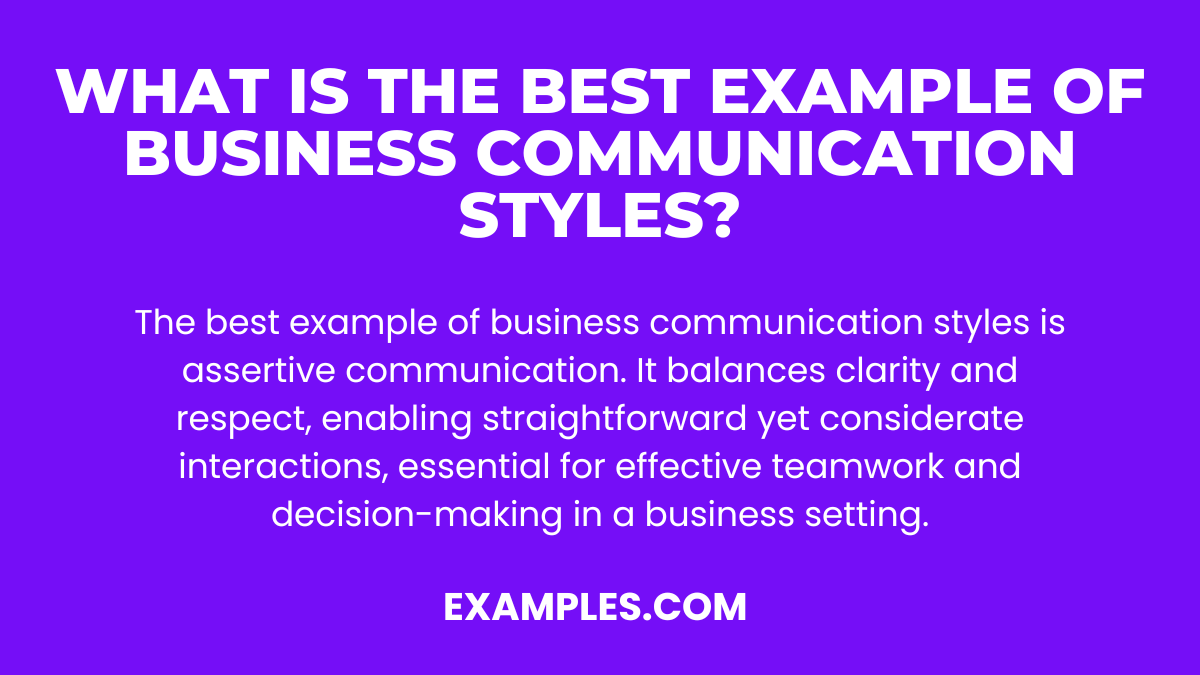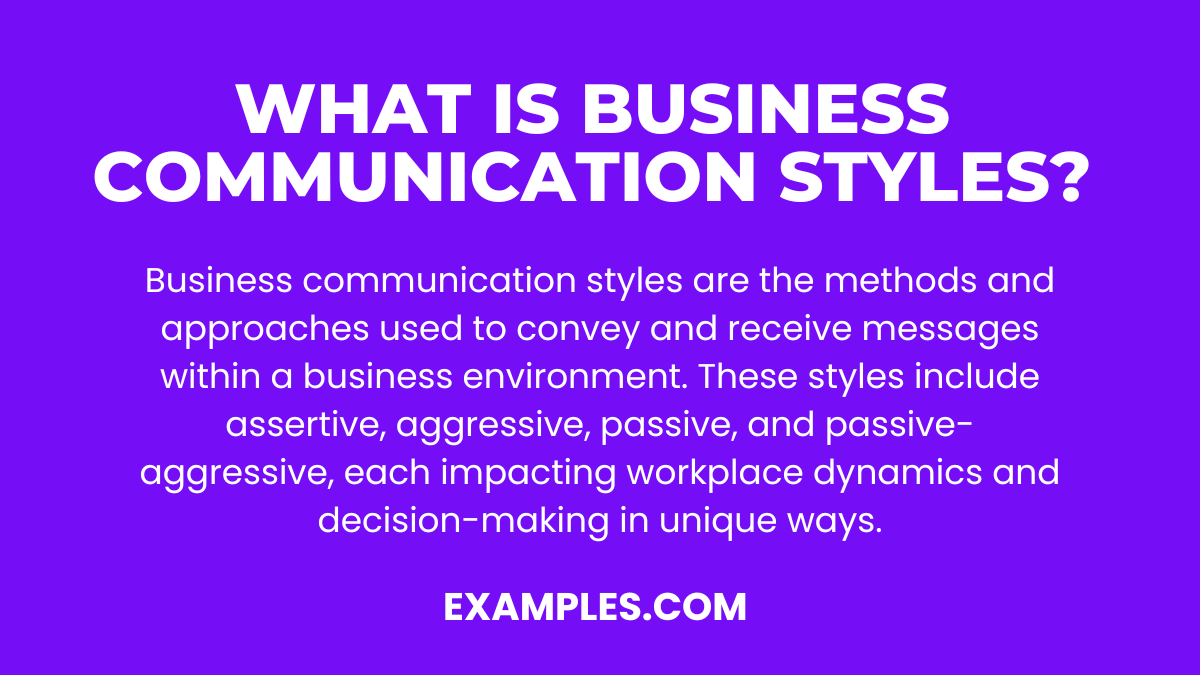20 Business Communication Styles Examples
Business communication styles are pivotal in shaping the dynamics of modern workplaces. This comprehensive guide delves into various styles, each with unique characteristics and impacts. From assertive to passive approaches, understanding these styles is crucial for effective team interactions and organizational success. We’ll explore real-world communication examples to illustrate how different methods influence workplace communication. Whether you’re a team leader or a new employee, this guide offers valuable insights into mastering the art of business communication.
Download Importance of Business Communication Style PDF
What is Business Communication Styles?
Business communication styles refer to the methods and approaches through which information is conveyed and exchanged in a business environment. These styles dictate how messages are delivered and interpreted among colleagues, teams, and departments within a company. They can vary greatly, ranging from formal and structured to informal and casual. Understanding and effectively using different communication styles is crucial for ensuring clear, efficient, and productive interactions in the workplace. Each style has its unique set of characteristics and is suitable for different situations and audiences. Effective business communication is key to maintaining a harmonious and dynamic work environment, fostering collaboration, and achieving organizational goals.
What is the best Example of Business Communication Styles?

Assertive communication strikes a balance between aggressive and passive styles, making it highly effective in a business setting. This style is characterized by clear, honest, and respectful expression of thoughts and opinions, ensuring that one’s message is conveyed without offending or belittling others.
In assertive communication, individuals express their needs and views confidently while also being open to feedback and other perspectives. This approach fosters an environment of mutual respect and understanding. For instance, during team meetings, an assertive communicator would confidently present their ideas, back them up with facts, and actively listen to others’ input, fostering a collaborative and productive discussion.
This style is particularly effective in conflict resolution, negotiations, and team collaborations, as it promotes open and honest dialogue. It encourages a culture where all voices are heard and valued, leading to more informed decision-making and a more inclusive workplace atmosphere. Assertive communication exemplifies how the right communication style can positively impact a business’s overall efficiency and employee satisfaction.
20 Business Communication styles Examples
In the realm of business, effective communication is the cornerstone of success. Mastering various communication styles is not just about conveying messages; it’s about fostering an environment where ideas flourish and conflicts are resolved constructively. Each style has its own causes and solutions, and understanding these can significantly enhance workplace interactions and productivity. From assertive to passive-aggressive, each style presents unique challenges and opportunities for improvement.
- Assertive Communication: Characterized by confidence and clarity.
Cause: A strong sense of self-respect.
Fix: Encourage open dialogue and respect for others’ opinions. - Aggressive Communication: Often loud and demanding.
Cause: Desire to dominate.
Fix: Foster empathy and active listening skills. - Passive Communication: Quiet and unassuming.
Cause: Fear of confrontation.
Fix: Build confidence and encourage assertiveness. - Passive-Aggressive Communication: Indirect and subtly hostile.
Cause: Avoidance of direct confrontation.
Fix: Promote direct and honest communication. - Direct Communication: Straightforward and to the point.
Cause: Valuing time and clarity.
Fix: Balance with active listening to others’ views. - Indirect Communication: Subtle and nuanced.
Cause: Cultural or personal preference for subtlety.
Fix: Encourage clarity while respecting nuances. - Formal Communication: Adheres to established protocols.
Cause: Organizational hierarchy and norms.
Fix: Adapt to more casual styles when appropriate. - Informal Communication: Casual and relaxed.
Cause: Comfortable workplace environment.
Fix: Ensure professionalism is maintained. - Nonverbal Communication: Relies on body language.
Cause: Unspoken cues and emotions.
Fix: Develop awareness of body language impact. - Emotional Communication: Expressive of feelings.
Cause: High emotional intelligence.
Fix: Balance with factual information. - Technical Communication: Uses specialized jargon.
Cause: Industry-specific knowledge.
Fix: Simplify language for broader understanding. - Diplomatic Communication: Tactful and considerate.
Cause: Desire to maintain harmony.
Fix: Ensure clarity is not sacrificed for diplomacy. - Transactional Communication: Focused on giving and receiving specific information.
Cause: Task-oriented interactions.
Fix: Encourage open-ended discussions for broader context. - Transformational Communication: Inspires and motivates.
Cause: Leadership and vision.
Fix: Ground in practical and achievable goals. - Collaborative Communication: Prioritizes teamwork and input.
Cause: Collective goal achievement.
Fix: Ensure all voices are heard. - Empathetic Communication: Understanding and supportive.
Cause: High emotional awareness.
Fix: Balance empathy with decision-making. - Reflective Communication: Thoughtful and measured.
Cause: Consideration of all aspects.
Fix: Encourage timely decision-making. - Proactive Communication: Anticipates needs and issues.
Cause: Forward-thinking approach. Fix: Balance with present needs. - Reactive Communication: Responds to situations as they arise.
Cause: Adapting to immediate circumstances.
Fix: Develop proactive strategies. - Narrative Communication: Tells stories for impact.
Cause: Utilizing storytelling for engagement.
Fix: Ensure relevance to the business context.
Business Communication Management Styles
Business communication management styles are essential frameworks that guide how leaders and managers interact with their teams and colleagues. These styles influence decision-making processes, team dynamics, and overall workplace culture. Understanding and implementing the right communication management style can lead to increased efficiency, enhanced employee morale, and improved organizational outcomes. From democratic to autocratic, each style has its distinct characteristics and applicability, depending on the situation and organizational goals.
- Democratic Communication: Encourages team input and shared decision-making.
Promotes a sense of ownership among team members. Best used in collaborative environments. - Autocratic Communication: Centralized decision-making with minimal input from others.
Effective for quick decision-making in crisis situations. - Transformational Communication: Focuses on inspiring and motivating employees towards a vision.
Ideal for leading change and fostering innovation. - Transactional Communication: Based on clear exchanges, often rewards or penalties.
Useful for task-oriented environments and achieving specific goals. - Laissez-Faire Communication: Offers minimal guidance, leaving team members to self-manage.
Works well with highly skilled and self-motivated teams. - Coaching Communication: Involves guiding and mentoring team members to develop skills.
Effective for personal development and team growth. - Affiliative Communication: Prioritizes creating emotional bonds and harmony.
Best used to build team cohesion and during conflict resolution. - Directive Communication: Involves giving specific directions and closely supervising tasks.
Useful in situations where precision and compliance are necessary. - Participative Communication: Encourages team members to participate in decision-making.
Fosters innovation and creative problem-solving. - Consultative Communication: Seeks input and advice but retains final decision-making authority.
Business Communication Styles in the Workplace
In today’s diverse and dynamic business landscape, understanding various communication styles in the workplace is essential for fostering effective collaboration and enhancing productivity. Different styles impact team dynamics, decision-making processes, and overall workplace culture. This section explores 10 unique and best examples of business communication styles, offering insights into their application and nuances within a professional setting. Each style, with its distinctive approach and impact, plays a crucial role in shaping the communication landscape of modern workplaces.
- Consultative Communication: Invites input and feedback. Encourages team involvement, leading to inclusive decision-making.
- Coaching Communication: Focuses on development and guidance. Aids in employee growth and skill enhancement.
- Facilitative Communication: Aims to guide discussions. Helps in reaching consensus and fostering team collaboration.
- Analytical Communication: Relies on data and facts. Ensures decisions are evidence-based and rational.
- Visionary Communication: Inspires and leads with a vision. Motivates teams towards a common goal.
- Instructive Communication: Directs and commands. Useful in situations requiring clear guidance and quick action.
- Democratic Communication: Values everyone’s opinions. Promotes a sense of equality and respect in teams.
- Strategic Communication: Focuses on long-term goals. Aligns team efforts with organizational objectives.
- Sympathetic Communication: Shows understanding and compassion. Builds trust and strengthens team bonds.
- Persuasive Communication: Aims to convince and influence. Effective in negotiations and when driving change
What are the Types of Business Communication Styles?
When discussing Business Communication styles, it’s crucial to recognize the variety of approaches and methods used in professional settings. Understanding these styles not only enhances interpersonal relationships but also optimizes organizational effectiveness.
- Assertive Communication: Assertive Communication is Direct and respectful, allowing for clear expression while considering others’ viewpoints.
- Aggressive Communication: Aggressive Communication is Dominant and forceful, often overpowering others’ opinions, leading to potential conflicts.
- Passive Communication: Passive Communication is Non-confrontational and reserved, often leading to unvoiced opinions and lack of clarity.
- Passive-Aggressive Communication: Passive-Aggressive Communication is Indirect and subtly hostile, masking true feelings and creating a confusing environment.
- Direct Communication: Direct Communication is Straightforward and to-the-point, emphasizing efficiency but sometimes lacking in emotional sensitivity.
- Indirect Communication: Indirect Communication is Subtle and nuanced, often relying on context and nonverbal cues for full understanding.
- Formal Communication: Formal Communication is Adheres to organizational protocols and structures, ensuring clarity in professional settings.
- Informal Communication: Informal Communication is Casual and relaxed, fostering a more personal and approachable environment.
- Empathetic Communication: Empathetic Communication is Focuses on understanding and addressing others’ emotions and perspectives, building trust.
- Collaborative Communication: Encourages teamwork and collective decision-making, valuing diverse inputs and consensus.
How to Work with Business Communication Styles?
Working effectively with various business communication styles is vital for fostering a collaborative and productive work environment. Understanding and adapting to these styles can greatly enhance your interactions with colleagues and clients, leading to better teamwork, clearer communication, and more successful outcomes.
- Identify the Communication Styles: The first step is recognizing the different styles present in your workplace. Pay attention to how your colleagues express themselves, the language they use, and their non-verbal cues. Are they direct or indirect? Do they prefer formal or informal communication?
- Adapt Your Style to Your Audience: Once you understand the prevalent communication styles in your environment, try to adapt your style accordingly. For instance, if you’re dealing with someone who prefers direct communication, be clear and concise in your interactions.
- Foster an Inclusive Environment: Encourage an atmosphere where all communication styles are respected and valued. This inclusivity can lead to a more cohesive team and better collaboration.
- Use Active Listening: Active listening involves paying full attention to the speaker, understanding their message, and responding thoughtfully. This skill is crucial in dealing with different communication styles and ensuring that everyone feels heard and understood.
- Provide Constructive Feedback: When working with various communication styles, it’s important to provide feedback that is constructive and empathetic. Tailor your feedback to the individual’s communication style for it to be more effective.
- Develop Flexibility: The ability to switch between different communication styles as the situation demands is a valuable skill in the workplace. This flexibility allows you to better connect with a diverse range of people.
- Respect Cultural Differences: In today’s global business environment, being mindful of cultural differences in communication is essential. Understanding these nuances can prevent misunderstandings and strengthen business relationships.
- Engage in Continuous Learning: The landscape of business communication is always evolving. Stay informed about new communication trends and techniques, and be open to learning and applying them in your interactions.
- Use Clear and Effective Communication: Regardless of the style, clarity and effectiveness in communication are key. Ensure that your message is understood as intended to avoid confusion and misinterpretation.
- Encourage Open Communication: Create an environment where open communication is the norm. Encourage team members to express their thoughts and opinions, which can lead to innovative ideas and solutions.
How Business Communication Styles can influence Workplace Culture?
Business communication styles significantly shape workplace culture, impacting everything from employee morale to overall productivity. A workplace’s communication approach can either foster a positive environment or lead to misunderstandings and conflicts.
- Assertive Communication: Promotes a culture of respect and clarity. This style encourages open dialogue, where everyone feels confident to express their opinions and ideas without fear of judgment. As a result, employees feel valued and respected, leading to a more engaged and motivated workforce.
- Aggressive Communication: Often creates a tense and uncomfortable environment. It can lead to a culture of fear and resentment, where employees may feel undervalued and reluctant to share their ideas. In such a setting, innovation and collaboration are often stifled.
- Passive Communication: While non-confrontational, can lead to a culture where issues are not addressed directly, causing unresolved conflicts and a lack of clear direction. This style might result in a lack of active engagement from team members and missed opportunities for improvement.
- Passive-Aggressive Communication: Creates an unpredictable and confusing environment. This indirect style of communication can lead to mistrust among team members, as the real issues are often masked behind sarcasm or backhanded comments.
- Collaborative Communication: Fosters a culture of teamwork and shared goals. In such an environment, employees feel their contributions are valuable, leading to higher job satisfaction and a sense of belonging.
- Direct Communication: Establishes a clear and efficient work environment. However, if not balanced with empathy, it can sometimes be perceived as blunt or insensitive, potentially impacting employee morale.
- Empathetic Communication: Leads to a supportive and understanding workplace culture. This style helps in building strong relationships among team members, making them feel supported both personally and professionally.
- Inclusive Communication: Ensures that all voices are heard and considered, fostering a culture of diversity and respect. This style is crucial in global businesses where multiple cultures and perspectives converge.
- Transparent Communication: Builds trust and integrity within the team. When leadership communicates openly about company policies, decisions, and challenges, it sets a tone of honesty and trust throughout the organization.
- Feedback-Oriented Communication: Creates a culture of continuous improvement and personal growth. Regular and constructive feedback helps employees to develop their skills and align their goals with that of the organization
How can Different Business Communication Styles Influence Decision-making Processes?
Different business communication styles significantly impact decision-making processes. Assertive and collaborative styles promote inclusive and well-rounded decisions by valuing diverse viewpoints. In contrast, aggressive or passive styles might lead to biased or under-explored decisions, as they either prioritize dominant voices or lack sufficient input and challenge. Therefore, the communication style in a business setting can directly influence the effectiveness and inclusivity of the decisions made.
The webpage from Princeton University’s UMatter program discusses four main styles of communication: passive, aggressive, passive-aggressive, and assertive. Each style is characterized by different behaviors and attitudes in expressing feelings, needs, and ideas. The page provides examples and descriptions of how these styles manifest in communication, highlighting their effects on interpersonal dynamics. Assertive communication is generally recommended for building respectful and long-term relationships, while acknowledging that other styles may be appropriate in certain situations. The content emphasizes the importance of adapting communication styles to foster healthier relationships.
The webpage from the University of Minnesota’s open textbook on Human Resource Management provides an in-depth look at communication strategies in a business context. It emphasizes the importance of emotional intelligence (EI) in effective business communication, outlining its five main aspects: knowing your emotions, managing your emotions, motivating yourself, recognizing and understanding other people’s emotions, and managing relationships. Additionally, the chapter discusses various communication styles in the workplace, including expresser, driver, relater, and analytical styles.




